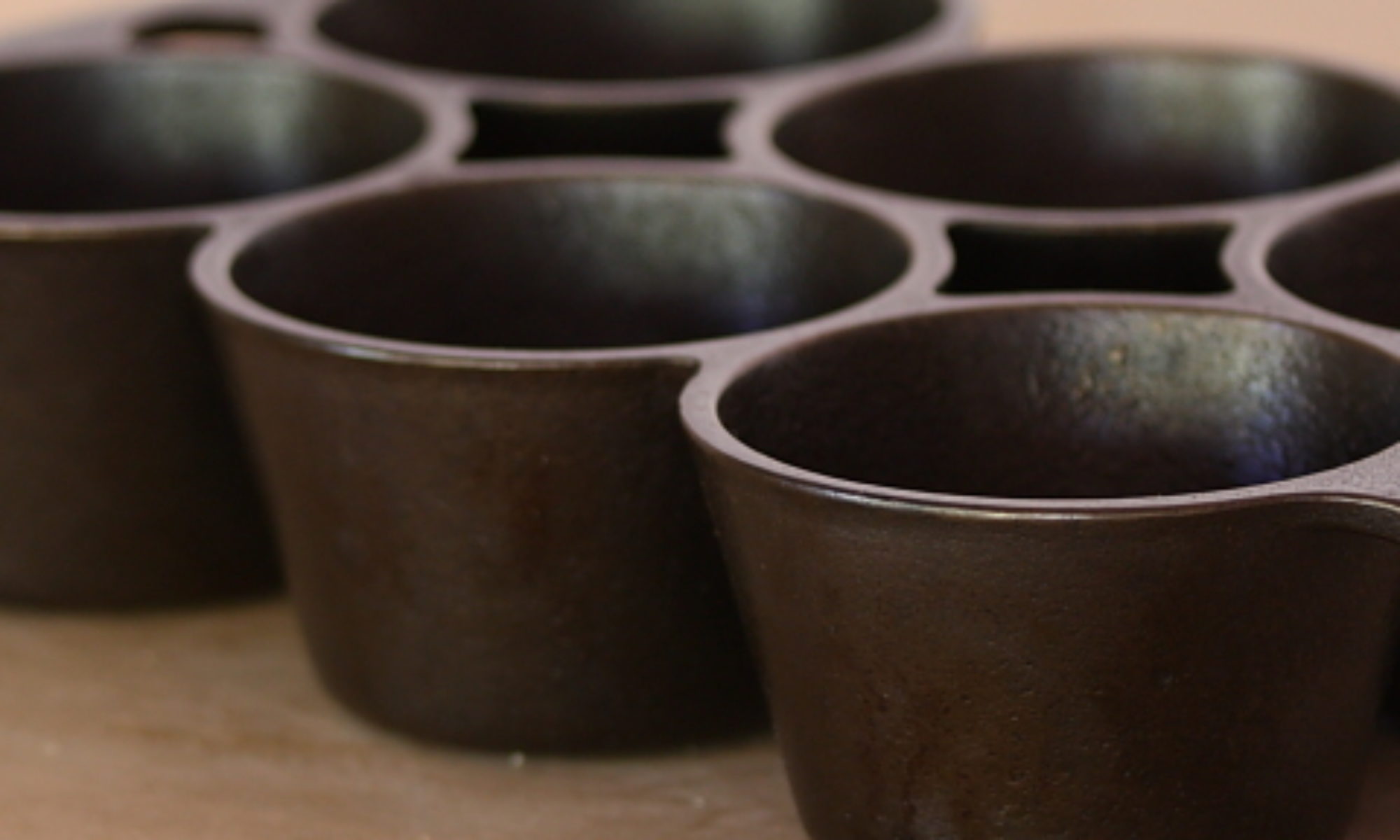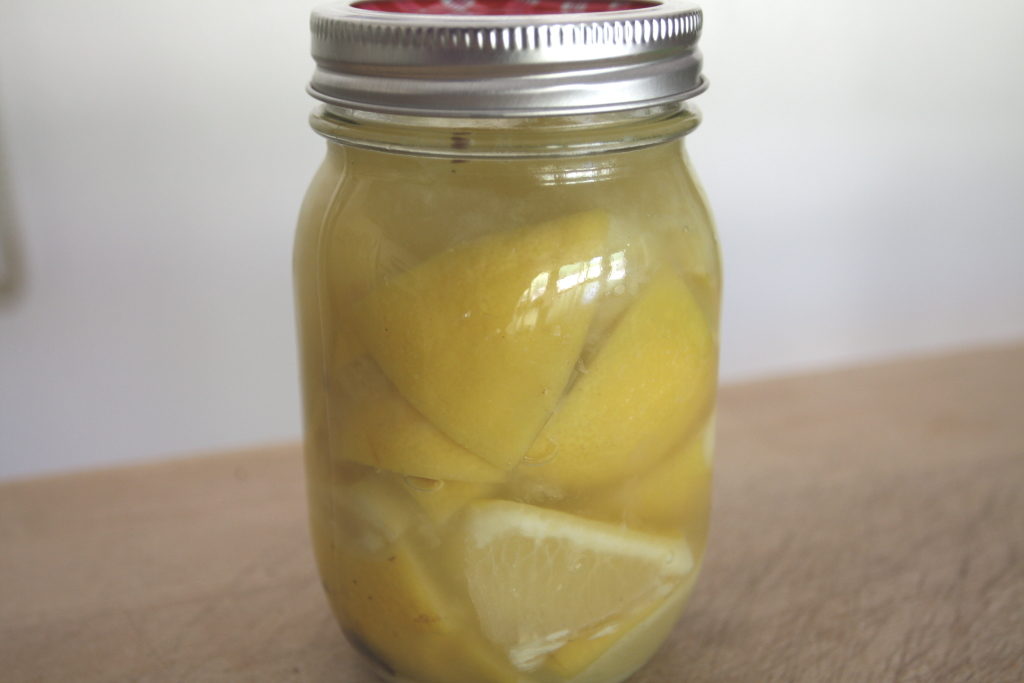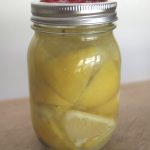
We’d seen this recipe in several books over the years, and, while we thought it was interesting enough to keep the recipe, we were never sure that we’d actually try it. We never really have a bunch of lemons all at once. Instead, we tend to buy them one or two at a time as we need them. Plus, we have no idea what these preserved lemons will taste like, so we didn’t want to buy lemons just to try it out. Then, when we had visitors last month, they left us with a bunch of fresh lemons; rather than make lemonade, we made preserved lemons.
We think that the first place we saw a recipe for preserved lemons (you can use limes, too, or a mix) was in Real Food Fermentation, by Alex Lewin, and it seemed like the perfect place to start a foray into making fermented foods. Other fermented foods include sauerkraut and some pickles, both of which we still want to try.
Preserved Lemons (or Limes)
Ingredients
- 60 g sea salt (1/4 cup)
- 3 cloves
- 1 bay leaf
- 3-5 lemons or 6 -10 limes, or a mix
Instructions
- If your lemons are waxed, pour boiling water over them and wash thoroughly.
- Sprinkle some salt in the bottom of a pint jar. Add cloves and bay leaf.
- Cut lemons in half, then into quarters, and remove seeds.
- Place 4 pieces of lemon in the jar, then press and pack them very tightly to release juice. Sprinkle with salt.
- Continue layering lemon pieces and salt, packing very firmly as you go.
- When jar is nearly full, add remaining salt, and press and pack tightly. If lemon juice does not cover the lemons, squeeze the juice from another lemon or two so the preserved lemons are submerged, leaving about an inch of space between the juice and jar lid.
- Let stand in a place away from sunlight for 2 or more weeks, pressing the lemons down under the liquid each day.
Ingredient discussion:
If possible, use organic lemons. Or organic limes. Just imagine how the pesticides would seep into everything as these babies ferment. Yuck. For the spices, we used a few cloves and a bay leaf, but, according to the original recipe, you could use a cinnamon stick, cardamom, a bit of pickling spice, etc. If you don’t have sea salt, use kosher, or, better yet, pickling salt. Iodized salt may result in a cloudy lemon pickle.
Procedure in detail:
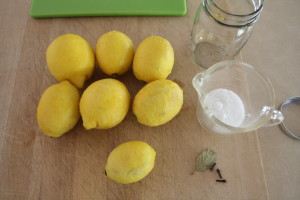
Wash lemons. If you don’t have organic lemons or if they’ve been waxed — almost all lemons in the store are waxed so they look shiny and stay moist — give them a good washing. The original recipe calls for a 30-second blanching. Basically, dip them into boiling water to remove the wax coating. We did something similar, even though we were pretty sure ours hadn’t been waxed. We boiled up a large kettle of water and slowly poured the boiling water over the lemons. Then we gave them a good washing, too. If you haven’t done so already, thoroughly wash a pint jar.
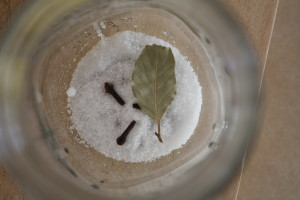
Sprinkle salt and spices. Sprinkle about 1/4 of the salt on the bottom of the pint jar. It doesn’t have to be exactly 1/4 of the salt, since the salt will dissolve into the lemon juice as the days pass, but add enough salt to cover the bottom. Add whatever spices you’re using; we used cloves and a bay leaf, but be creative and use what you like.
Chop lemon. Working with one lemon at a time, cut each in half, and then cut each half into four pieces. Remove the seeds, or at least most of them; we’re sure you’ll miss one or two seeds, as we did. We suggest working with one lemon at a time, since you’ll be less likely to have a bunch of chopped lemon that won’t fit into the jar.
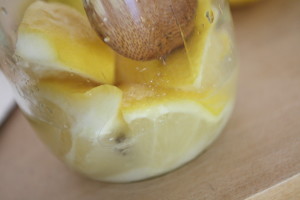
Layer. Place four pieces of lemon in the jar and use a wooden spoon, or any spoon, really, to press them down and release their juice. Sprinkle a layer of salt over the top, followed by another layer of lemon. Continue, adding lemon and salt, pressing and packing as tightly as you can, until the jar is nearly full. You’ll want about an inch of space at the top. Sprinkle the remaining salt on top.
Add juice. Now, if you have juicy lemons, as we had, all the lemon pieces will be submerged by the juice. If not, squeeze enough lemon juice to cover.
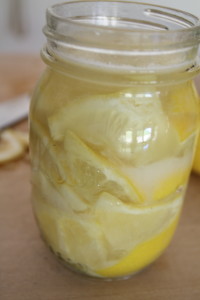
Ferment. We know this is going to seem odd, especially to people who haven’t fermented anything before, but here goes. Seal the jar and leave it to sit at room temperature someplace out of the sun, but someplace where you won’t forget it. We placed it in a darkish corner of our counter so we’ll see it daily. Why? Because, every day, you need to take off the lid, and use a spoon to press down the lemons so they’re submerged while they ferment. Continue to do this for 2 weeks, or longer. After pressing the lemons, taste the spoon and continue fermenting until it tastes good to you. Then refrigerate.
N. B. You might see mold growing on the surface. If it’s a small amount, you can skim it off and continue along your merry way with no harm, but, if it’s a lot, perhaps you should dump it and start over. Just use common sense.
We’ve only pressed these lemons for a couple of days, and they’re starting to change. Right now, it tastes mostly like a salty lemon juice, but it does have a slight tanginess that we think might be coming from the fermentation, so we’re hesitant to rate them. We’re sure the biggest question you have is what do you do with these preserved lemons? We’re thinking that they’ll go well in sauces, such as a lemon caper sauce, and a small amount will taste great in soup or salad dressing; basically any place where you’d use some sort of acid (vinegar or lemon juice) to bring out flavor.
